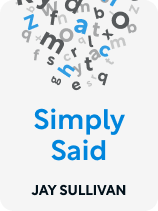

This article is an excerpt from the Shortform book guide to "Simply Said" by Jay Sullivan. Shortform has the world's best summaries and analyses of books you should be reading.
Like this article? Sign up for a free trial here .
What makes a good presentation? What are some things you should keep in mind when delivering a business presentation?
An effective presentation is one that distills your message clearly and concisely, leaving no room for interpretation in your audience’s mind. To that end, you must define one main idea your want to convey and flesh out your talking points around it.
Here are a few tips on how to prepare and deliver an effective presentation that gets your message across.
How to Prepare a Clear and Engaging Message
Whether you’re talking one-on-one with a client or presenting to an audience of hundreds, your goal is to make it easy for the other party to understand your point. In this article, we’ll discuss what makes a good presentation and provide some tips for delivering a strong, memorable message that won’t be open to misinterpretation.
Tip #1: Know What You Want to Say
Sullivan recommends that before you speak, you determine the one main idea that you want your audience to take away from your meeting or presentation. He writes that many speakers often don’t know what their main point is, which is problematic—if you’re confused about your main point, then the audience is likely to be confused too. So clarify your main point before you flesh out your presentation to ensure that your audience will receive the message you intend. For example, if you’re presenting sales data from two quarters, decide ahead of time what you want your team to take away—should they be celebrating an improvement, reflecting on poor performance, or brainstorming for the future?
(Shortform note: To know if you’ve developed a clear core message, check for three signs: 1) It captures what your presentation is about, 2) your audience can easily repeat it, and 3) all the information you present is connected to it.)
Sullivan advises that you communicate this key message in a way that’s short and simple: State it in just one sentence with fewer than 10 words. Save secondary details—like the why’s and how’s—for succeeding sentences. Only use industry jargon with people in your industry, and avoid big words and corporate-speak. For example, instead of saying, “We must all determine and leverage our core competencies to administrate exceptional synergy and increase efficiency,” state it simply as, “Let’s pool our strengths to work together more efficiently.”
(Shortform note: Sullivan cautions against flexing your vocabulary in an attempt to sound smart. In an interview, he says that trying to sound smart only makes you sound full of yourself. If you want to come off as smart, just make it easier for the other person to understand you.)
Tip #2: Create an Organized Presentation
Once you know what you want to say, it’s time to work on how you’re going to present it to your audience. Sullivan says that effective presentations follow a standard format for communicating information: Tell them what you’re going to tell them, tell them, then tell them what you just told them. (Shortform note: This format allegedly originated from Aristotle, the Greek master of rhetoric; 2,500 years later, it’s still being taught.)
Sullivan’s version of this classic structure comprises six parts:
1) Have a strong opener. Immediately grab your audience’s attention with a problem, a fact, a statistic, a rhetorical question, or a powerful image. For example, if you’re trying to convince management to allow remote work, you can begin your presentation with how much money your department loses as a result of workers’ commutes. This would make a strong opener because it piques the audience’s interest—they would want to know what the relationship is between commuting and the bottom line.
2) Deliver your conclusion first. Instead of saving your conclusion for last, reveal your recommendation up front. Sullivan says that this keeps the audience from getting impatient and gives them the proper context, making it easier for them to follow the rest of the presentation. Otherwise, they’ll spend the whole time trying to figure out where you’re leading them.
Continuing the previous example, your recommendation can be, “We need to switch to a remote working setup.” (Remember: one sentence with fewer than 10 words.) After you clearly state your recommendation, you can then go into the details: “We will need to establish a dedicated communication channel, set common availability hours, and schedule regular check-ins to ensure that work stays on track.”
3) Answer: “What’s in it for them?” Stick to Sullivan’s premise of focusing on other people by identifying three to five benefits of your recommendation for your audience. Sullivan writes that the most effective benefits are geared toward the universal motivators of time, feelings, and money. List all these benefits in one slide. For example: “If we switch to a remote working setup, we’ll be able to: 1) increase productivity, 2) allow for more flexible hours, and 3) save on office space expenses.”
4) Back up the benefits with data. If you’re using visuals, after stating the benefits on one slide, use succeeding slides to prove that these benefits are real. Sullivan recommends devoting one slide for every benefit mentioned and using statistics, testimonials, or anecdotes to convince your audience that the benefits are evidence-based.
For example: “Increase productivity: Our workers commute an average of 90 hours per year—the equivalent of two-and-a-half working weeks. This results in lost productivity: Since workers have to get up early and get home late, they suffer from disrupted sleep, reduced work-life balance, and more sick days. If we shift to remote work, we may initially experience reduced productivity; however, research shows that after the adjustment period, productivity can increase by as much as 47%.”
5) Recap. Following the traditional format, summarize what you just discussed: Reiterate your recommendation and briefly repeat the benefits. (Shortform note: Research supports Sullivan’s advice to restate your recommendation at the end so that people will get your message. This is because of the audience attention curve: While the average audience member may pay close attention to the beginning and end of a presentation, their attention drops by as much as 90% in the middle of it.)
6) Outline action steps. Clearly state the next steps and who’s responsible for them, says Sullivan. This ensures accountability.
For example: “If you approve this recommendation by the end of the month, we will start the transition to remote work by Week 1 of next month. Jeff will coordinate with Maya from IT to set up our cloud-sharing facility and communication channel. In Week 2, I will outline the team’s deliverables and deadlines for the next two months and plot our regular check-in times. In Week 3, Team A will serve as our pilot group and begin working from home. In Week 4, Team A and I will submit a report about what worked and what needs to be improved.”
Put Together Your Slide Presentation
You don’t have to work on your presentation in the order listed above. In fact, Sullivan says it’s often easier to start with your main message and benefits before working on your opener. Once you’ve made your notes, you can create a slide presentation (also known as a slide deck) on a program like PowerPoint or Google Slides, keeping the following tips in mind:
- Make it easy for your audience to digest the information. Use short bullet points instead of sentences, with a maximum of six words per bullet and six bullets per slide. Don’t include bullets that you won’t discuss.
- If you’re adding bullet points to a slide with a graph or chart, make sure the bullets enhance—rather than merely repeat—the visual information.
- Don’t use sounds or animation that may be distracting for your audience.
Present From Your Slide Deck
Your job doesn’t end with putting together a solid slide deck—you still have to talk about your message. Your slides merely serve as a tool to help the audience more easily understand what you have to say. To improve your delivery when presenting with a slideshow, Sullivan recommends that you:
1) Make the audience feel like they have your full attention. Stand to the left of the screen from the audience’s point of view, making sure that your body is oriented toward them.
2) Stand in one place. While moving around the room has its advantages, it distracts your audience and divides their attention between you and the screen.
3) Look at your slide, turn to your audience to repeat what it says, then add more details. While other communication experts say that the audience doesn’t like it when a speaker reads off their slides, Sullivan argues that this is only true when the speaker doesn’t add more information. He says reading what’s on your slides helps your audience absorb your message better because both their sight and hearing are focused on the same information. In other words, adding more information is important after reading the exact text on your slides to help your audience process it.

———End of Preview———
Like what you just read? Read the rest of the world's best book summary and analysis of Jay Sullivan's "Simply Said" at Shortform .
Here's what you'll find in our full Simply Said summary :
- A blueprint for effective business communication
- How to create and deliver memorable presentations
- How to write documents and emails that people will actually read






